A designer drug is a structural or functional analog of a controlled substance that has been designed to mimic the pharmacological effects of the original drug, while avoiding classification as illegal and/or detection in standard drug tests. Designer drugs include psychoactive substances that have been designated by the European Union as new psychoactive substances (NPS) as well as analogs of performance-enhancing drugs such as designer steroids. Some of these were originally synthesized by academic or industrial researchers in an effort to discover more potent derivatives with fewer side effects, and shorter duration and were later co-opted for recreational use. Other designer drugs were prepared for the first time in clandestine laboratories. Because the efficacy and safety of these substances have not been thoroughly evaluated in animal and human trials, the use of some of these drugs may result in unexpected side effects.

Synthetic cannabinoids are a class of designer drug molecules that bind to the same receptors to which cannabinoids in cannabis plants attach. These novel psychoactive substances should not be confused with synthetic phytocannabinoids or synthetic endocannabinoids from which they are in many aspects distinct.
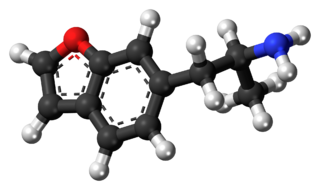
6-APB is an empathogenic psychoactive compound of the substituted benzofuran and substituted phenethylamine classes. 6-APB and other compounds are sometimes informally called "Benzofury" in newspaper reports. It is similar in structure to MDA, but differs in that the 3,4-methylenedioxyphenyl ring system has been replaced with a benzofuran ring. 6-APB is also the unsaturated benzofuran derivative of 6-APDB. It may appear as a tan grainy powder. While the drug never became particularly popular, it briefly entered the rave and underground clubbing scene in the UK before its sale and import were banned. It falls under the category of research chemicals, sometimes called "legal highs." Because 6-APB and other substituted benzofurans have not been explicitly outlawed in some countries, they are often technically legal, contributing to their popularity.

MDA-19 (also known as BZO-HEXOXIZID) is a drug that acts as a potent and selective agonist for the cannabinoid receptor CB2, with reasonable selectivity over the psychoactive CB1 receptor, though with some variation between species. In animal studies it was effective for the treatment of neuropathic pain, but did not effect rat locomotor activity in that specific study. The pharmacology of MDA-19 in rat cannabinoid receptors have been demonstrated to function differently than human cannabinoid receptors with MDA-19 binding to human CB1 receptors 6.9x higher than rat CB1 receptors.

UR-144 (TMCP-018, KM-X1, MN-001, YX-17) is a drug invented by Abbott Laboratories, that acts as a selective full agonist of the peripheral cannabinoid receptor CB2, but with much lower affinity for the psychoactive CB1 receptor.

AB-005 or [1-[(1-methylpiperidin-2-yl)methyl]-1H-indol-3-yl](2,2,3,3-tetramethylcyclopropyl)-methanone is a designer drug offered by online vendors as a cannabimimetic agent. The structure and pharmacological activity of AB-005 was published in 2010, prior to its commercial availability in 2012, where it was reported to have high affinity for both CB1 and CB2 receptors. AB-005 features groups found in other previously reported synthetic cannabinoids: the tetramethylcyclopropane group of UR-144 and XLR-11 as well as the (1-methyl-2-piperidinyl)methyl substituent of AM-1248 and AM-1220. No information regarding the in vivo activity of AB-005 has been published, and only anecdotal reports are known of its psychoactivity in humans.

α-Pyrrolidinohexiophenone is a synthetic stimulant drug of the cathinone class developed in the 1960s which has been reported as a novel designer drug.

MDMB-FUBINACA (also known as MDMB(N)-Bz-F and FUB-MDMB) is an indazole-based synthetic cannabinoid that is a potent agonist for the cannabinoid receptors, with Ki values of 1.14 nM at CB1 and 0.1228 nM at CB2 and EC50 values of 0.2668 nM at CB1 and 0.1411 nM at CB2, and has been sold online as a designer drug. Its benzyl analogue (instead of 4-fluorobenzyl) has been reported to be a potent agonist for the CB1 receptor (Ki = 0.14 nM, EC50 = 2.42 nM). The structure of MDMB-FUBINACA contains the amino acid 3-methylvaline or tert-leucine methyl ester.
BzODZ-EPyr is an indole based synthetic cannabinoid that has been sold as a designer drug in Russia.

2-Fluorodeschloroketamine is a dissociative anesthetic related to ketamine. Its sale and use as a designer drug has been reported in various countries. It is an analogue of ketamine where the chlorine group has been replaced by fluorine. Due to its recent emergence, the pharmacological specifics of the compound are mostly unclear.
This is an overview of the legality of ibogaine by country. Ibogaine is not included on the UN International Narcotics Control Board's Green List, or List of Psychoactive Substances under International Control. However, since 1989, it has been on the list of doping substances banned by the International Olympic Committee and the International Union of Cyclists because of its stimulant properties.

EG-018 is a carbazole-based synthetic cannabinoid that has been sold online as a designer drug. It acts as a partial agonist of the CB1 and CB2 receptor, with reasonably high binding affinity, but low efficacy in terms of inducing a signaling response.

CUMYL-CH-MEGACLONE is a gamma-carboline based synthetic cannabinoid receptor agonist that has been sold as a designer drug, first being identified in Hungary in December 2018.
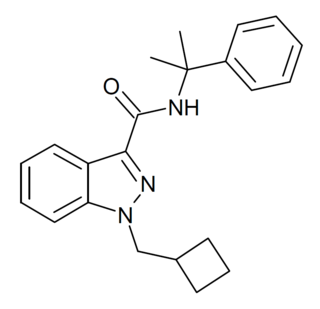
CUMYL-CBMINACA (SGT-277) is an indazole-3-carboxamide based synthetic cannabinoid receptor agonist that has been sold as a designer drug, first being identified in Germany in February 2020. It is illegal in Finland.

CUMYL-FUBINACA (SGT-149) is an indazole-3-carboxamide based synthetic cannabinoid receptor agonist, with an EC50 of 1.8nM for human CB1 receptors and 23.7nM for human CB2 receptors, giving it around 13x selectivity for CB1. It has been sold online as a designer drug.
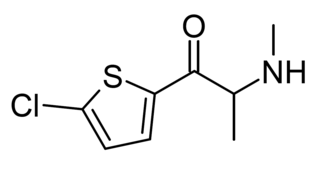
5-Chloro-β-keto-methiopropamine (5-Cl-βk-MPA) is a recreational designer drug with stimulant effects. It is a substituted cathinone derivative with a thiophene core, closely related to better known drugs such as βk-Methiopropamine and mephedrene. It was first identified in Hungary in 2017, and was made illegal in Hungary in 2018, and in Italy in 2020.

ZDCM-04 is a recreational designer drug with psychedelic effects. It is a phenethylamine derivative which is claimed to act as a prodrug for DOC and theophylline in the same way in which fenethylline acts as a prodrug for amphetamine and theophylline. ZDCM-04 was made illegal in Italy in March 2020.
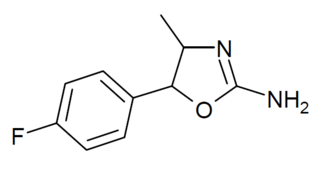
4'-Fluoro-4-methylaminorex (4-FPO) is a recreational designer drug from the substituted aminorex family, with stimulant effects. It was first detected in Slovenia in 2018. It was made illegal in Italy in March 2020.
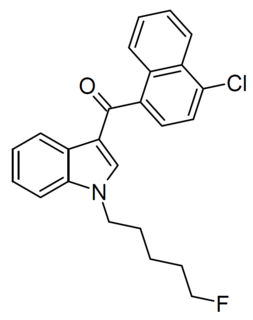
5F-JWH-398 is a recreational designer drug which is classed as a synthetic cannabinoid. It is from the naphthoylindole family, and produces cannabis-like effects. It was legally sold in New Zealand from 2012-2014 under the psychoactive substances scheme but was discontinued in May 2014 following the end of the interim approval period under the Psychoactive Substances Act 2013. Subsequently it has appeared on the illicit market around the world and was identified in Germany in May 2019.
Synthetic drugs refer to substances that are artificially modified from naturally-occurring drugs and are capable of exhibiting both therapeutic and psychoactive effects.
















